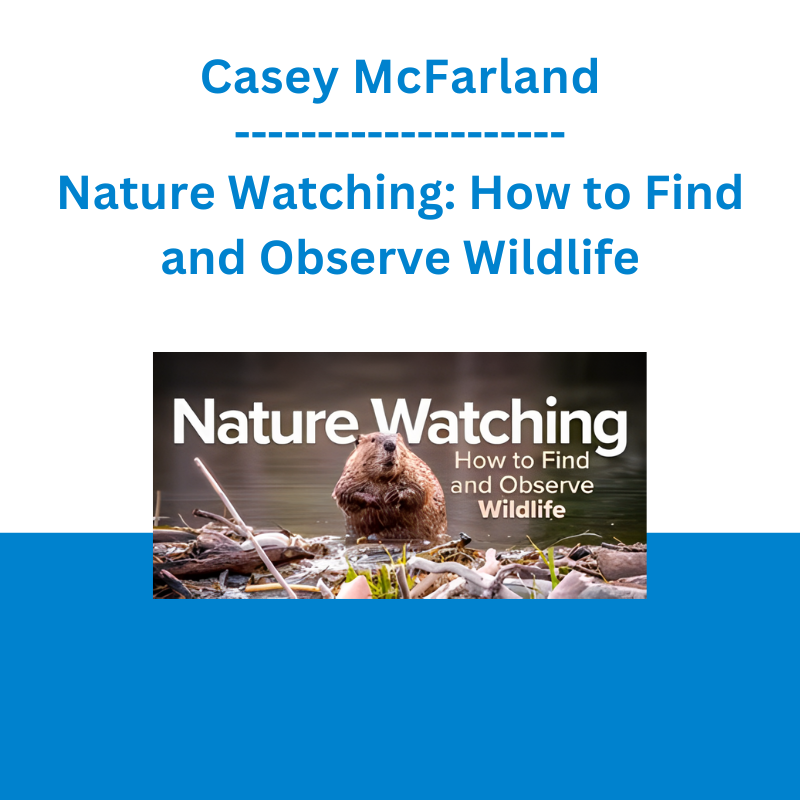*** Proof of Product ***
Exploring the Essential Features of “Casey McFarland – Nature Watching: How to Find and Observe Wildlife”
Nature Watching: How to Find and Observe Wildlife
Travel into the stunning beauty of the natural world with a professional tracker and learn the fascinating skills of wildlife tracking.
EPISODE
Trailer
01:Signs and Sounds of the Wild
Learn about the field of wildlife tracking and how it allows us to intimately know the natural world and environment. Grasp what kinds of knowledge and information tracking reveals, both about wildlife and about ourselves. Preview the different aspects of tracking you’ll study in the course, from animal camouflage and movement to trails, migration, foot morphology, marking behaviors, and much more.
18 min
02:Bugs and the Backyard Serengeti
Take account of the huge wealth of insect life found in our ecosystems, and of the vital role of insects in the food chain. Explore the world of beetles, where to see them, and the characteristic tracks they leave. Also learn about the unique trails of caterpillars and millipedes, the lore of the cicada and the three kinds of sign they leave, and the picturesque sign of slugs and snails.
18 min
03:What Feathers Tell Us about Birds and Flight
Delve into the wonder of bird feathers, beginning with the anatomy and function of flight feathers, as they provide propulsion and lift. Study four categories of wing design, serving functions from maneuverability and distance flying to high speed and soaring. Learn how to identify birds by their feathers found in the wild, and about the information that feathers reveal.
22 min
04:Paws, Claws, and Hooves: Who Stepped Here?
Today, look closely at some common animal tracks, and the concept of signatures, the features of a track that allow for quick, accurate identification. Begin with the tracks of cats and beavers, as they appear in different ground conditions. In the examples of deer, dogs, cats, and rabbits, see how track signatures can identify behaviors, and how we can identify animals from fragmentary tracks.
18 min
05:Migratory Trails Explain Much about Life
View animal migration and trails from two perspectives. First, investigate why animals migrate, and what we can learn about their behavior from their trails. Then, take account of how animal movement benefits ecosystems and the cycle of life. Learn about the best places to look for trails, how to study the ground for tracks, and key questions to ask when examining and interpreting trails.
16 min
06:Camouflage and Becoming Invisible
Study the essentials of how to blend into the environment when tracking wildlife, in terms of both camouflage and movement. Modeling how animals do it, grasp how to adjust your movement to a relaxed pace and demeanor, while pausing, looking, and listening. Also, practice complete stillness. Take note of how to dress to match the surroundings, and other key strategies for going unnoticed.
14 min
07:Bird Nests and the Stories They Tell
Bird nests show us how birds think, and the ways they interact with the larger landscape around them. Learn the basics of nest identification, beginning with how nests are built in distinct layers. Note the four types of materials birds use, and the spectrum of nest types. Witness the nest building of redwing blackbirds, robins, and cliff swallows, which tells us much about the birds’ lifestyles.
23 min
08:Animal Bedding and the Dream World of Deer
Consider sleep as an essential activity for animals, which carries risk. Study bedding spots, as they reveal the relationship between an animal and the land, leaving signs on the landscape. Explore the bedding behavior of deer, and how deer feeding is related to bedding behavior. Look at the features of a deer bed, where to find them, and what we can learn from impressions and marks in deer beds.
18 min
09:Using Your Eyes and Ears Outdoors
Tapping into your own senses is one of the fundamentals in building the skill of wildlife tracking, and in deepening your sensitivity to the landscapes you encounter. Grasp how we absorb the surrounding environment through our senses, and practice exercises to heighten your hearing, sight, touch, and smell. Experience how sensory work can transform our appreciation of the natural world.
20 min
10:Marking Behavior: What a Funny Way to Talk
Look into the amazing ways animals gather and convey information. Investigate scent marking, how scent is produced in animal physiology, and the many methods animals use to apply their scent to the environment. Take account of the numerous uses of scent, from delineating territory and intraspecies communication to “marking spots,” places where animals keep tabs on their own and other species.
19 min
11:Bird Language and the Art of Listening
Examine how animals communicate and what we can learn from their calls. Focusing on bird vocalization, develop your awareness of birds’ vocal inflections and body language, as they reflect conditions from well-being to danger. Note the benefits of tuning in to the “soundscape” of wildlife voices, in connecting us to place and building awareness of what’s happening in the woods.
10 min
12:Trees and Life: Food, Homes, and Communication
Explore the fascinating range of animal sign found on trees. Begin with sapsuckers, woodpeckers who drill beautiful sap wells on many tree species. Observe how animals mark trees for various kinds of communication, nest in tree cavities, and use bark and other tree material for nest building. Also, learn how many animals consume cambium, the inner vascular tissue of trees.
21 min
13:Wildlife Mating Behavior
Animal mating leaves observable signs on the landscape if we know what to look for. Investigate buck rubs, where male deer mark trees with their antlers, a form of social and mating expression. Explore the incredible process of antler growth and learn how antlers figure in mating and communication. Then, study the intriguing mating rituals of cottontail rabbits, and the characteristic tracks their mating activity leaves in the earth.
16 min
14:Making a Map with the Moon, Clouds, and Stars
Contemplate the value of maps, in orienting us to our environment. Using a compass, create your own internal map of your surroundings, connecting with your home landscape, using landmarks such as natural features, bodies of water, buildings, and meaningful places. From the center of your map, learn to track the movements of the Sun and Moon, and how to tell the time using the constellations.
17 min
15:How Long Ago Was an Animal Here?
Tracking places an animal not only in space, but in time. Learn to estimate the relative age of animal tracks. Assess the quality of a track; the spot where the track is found; and grasp how fresh tracks change through the effects of time, weather, and ground conditions. Note how we can reconstruct much about an animal’s movements and behavior by the features and timeline of their tracks.
15 min
16:Holes, Burrows, and Life Underground
Animal life below ground also leaves valuable evidence for us as trackers. Discover the massive tunnel complexes of prairie dogs, and their many benefits to ecosystems. Consider the challenges of identifying holes and burrows, and some key parameters for examining them. Observe the burrowing habits of badgers, coyotes, bears, and others, and what the contours of digs tell us about who made them.
9 min
17:What Scatology Teaches If We Don’t Look Away
Animal scats reveal the relationship between an animal and the landscape and what resources are available to them, offering a range of valuable information for tracking. Study how animals manage food digestion differently, leading to unique features of scats that aid identification. See what we can learn about animal movements, diet, lifestyle, and behavior from the scats they leave behind.
20 min
18:Is That a Front or Back Foot? Left or Right?
As a core skill of tracking, learn to distinguish front/back and right/left animal tracks, first comparing those of dogs and cats. Investigate raccoons’ hand-like tracks and note that understanding their structure allows us to identify similar features in otters, mink, bears, and many other mammals. Finish with the tracks of each wild canine in the United States, and the tracks of birds.
20 min
19:Gaits: How Animals Walk and Run
Gait patterns offer a world of information about a moving animal. See how the way an animal moves and its speed are reflected in its tracks. Learn to recognize four basic gait patterns that apply to a spectrum of mammals: the walk, trot, lope, and gallop, plus two variations. Take account of what we can discern from these patterns about an animal’s behavior, movements, and emotional state.
19 min
20:Exploring the World of Winter Wildlife
Take a broad look at the strategies animals use to survive in winter landscapes, encompassing those of birds, mammals, insects, and amphibians. For winter tracking, investigate trail patterns in snow, and how gait patterns change according to snow conditions. Also, grasp how snow texture, moisture, and temperature affect how an animal’s tracks appear, and how they change over time.
16 min
21:Becoming a Great Tracker
Trailing is the art of following an animal’s movements over distance. Learn how to practice the basics of trailing. Tune in to how tracks look in different ground conditions. Scan for obvious routes the animal may travel; for patches of ground showing clear evidence of tracks; and orient yourself with anchor tracks, the last clear tracks along the trail. Build the skill of scanning out ahead, with eyes up.
17 min
22:Advanced Tracking and Trailing
Refine your skill in trailing an animal with the strategies seasoned trackers use. Learn to intentionally control your pace, move smoothly, and probe the entire landscape around you. Build the habit of constantly monitoring the direction of air currents, as an aid to going undetected. Pay attention to all sounds around you and grasp how to recover an animal’s trail when you lose it.
16 min
23:What the Beaver Teaches Us about Our Planet
Take stock of the amazing ecological role of beavers, as they deeply affect the ecosystems where they live and the other animals around them, altering landscapes and transforming forests into wetlands and pond systems. Take note of the many benefits of beavers’ activity, their remarkable dams and scent mounds, and compare beavers’ impact on the planet with our own, both positive and negative.
15 min
24:Testing Yourself: The Wildlife Tracking Exam
Look briefly at the work of CyberTracker Conservation, as it exists to preserve tracking expertise. Conclude the course with an informal exam, highlighting important principles and materials from the episodes. Use the exam questions to both review what you’ve learned and expand on it, as you revisit subjects such as camouflage, animal trails, bird flight, track aging, marking, burrows, and more.
21 min
DETAILS
Overview
The skill of wildlife tracking offers an extraordinary window into our natural environments. In this course, you’ll learn the core elements of tracking, such as identifying and interpreting animal tracks; tracking the amazing world of birds; the language of animal marking; going invisible; bedding, nesting, and mating in the wild; and the art of trailing, as you discover a richly rewarding way of knowing the world.
About
Casey McFarland
Footprints and other animal sign, like nests and beds and the wild language of the woods, can tell incredible tales if you know how to interpret them.
Casey McFarland is a Senior Tracker and Evaluator for CyberTracker Conservation, a nonprofit organization that educates and certifies professional wildlife guides and amateur naturalists around the world. He is also a wildlife guide and naturalist. He coauthored the Peterson Field Guide to North American Bird Nests and Bird Feathers: A Guide to North American Species, and he contributed to Mark Elbroch’s Mammal Tracks & Sign: A Guide to North American Species
REVIEWS
Annhunk
Exceptional guide, there’s nothing else like it!
This guide is so easy to use and chock full of incredible information, stunning videos and photos, unusual facts that all add up to an amazing experience of the natural world in every aspect you can think of. You will walk away understanding so vastly much more about animals and how to see them and understand the signs they leave, many of which you probably never imagined before.
Anonymous
Excellent compilation!
Casey is not only an amazing tracker, he is a fantastic teacher, and an engaging presenter. Nature makes humans better in every way, and understanding the stories in the land brings that experience to a whole new level. Learn, appreciate, protect, and enjoy.
Please see the full list of alternative group-buy courses available here: https://lunacourse.com/shop/










 Ega Radiegtya - Video Tutorial React Native dan Redux
Ega Radiegtya - Video Tutorial React Native dan Redux  Erik Banks - Alternative Risk Transfer
Erik Banks - Alternative Risk Transfer